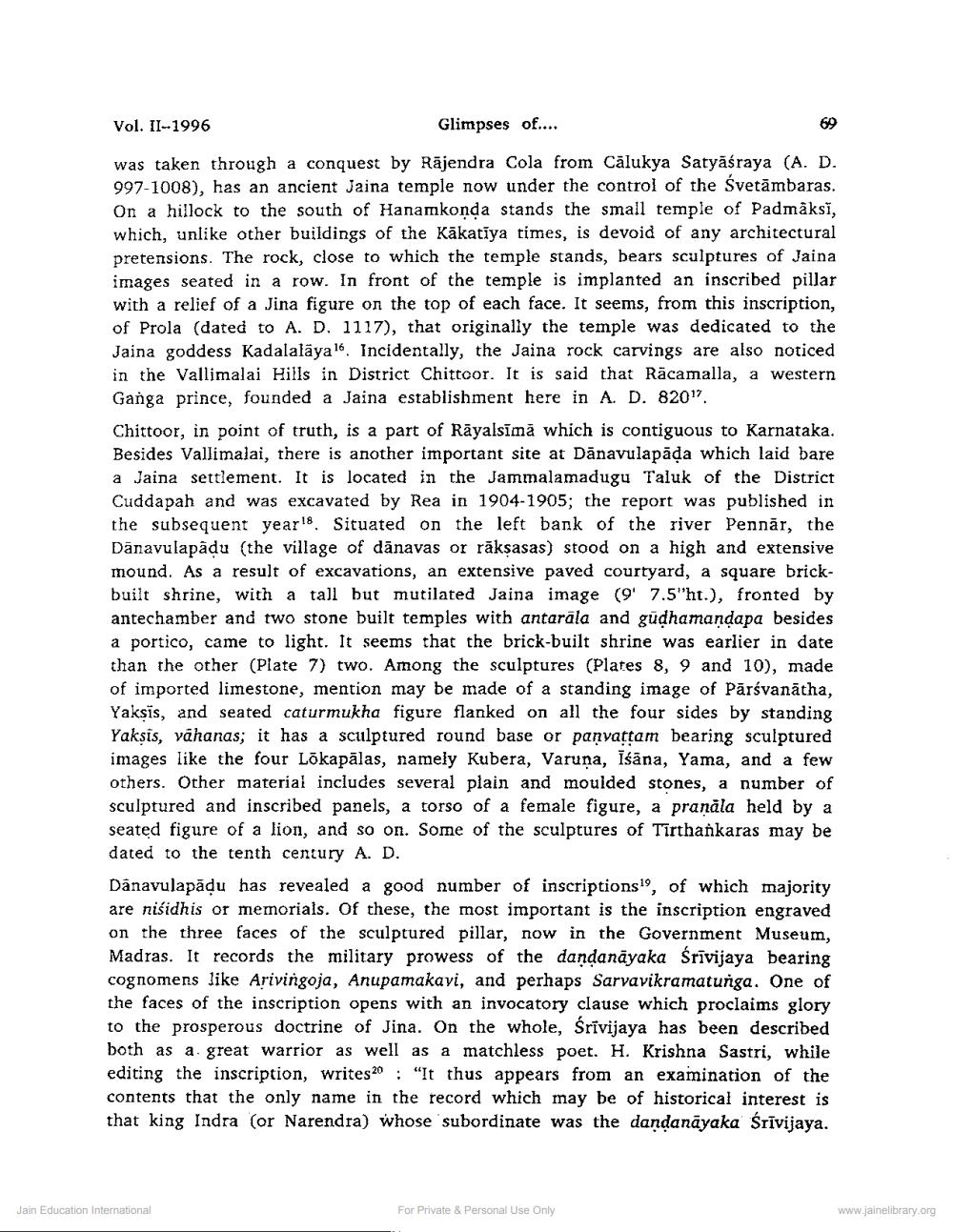________________
Vol. II-1996
Glimpses of....
69
was taken through a conquest by Rajendra Cola from Calukya Satyaśraya (A. D. 997-1008), has an ancient Jaina temple now under the control of the Svetambaras. On a hillock to the south of Hanamkonda stands the small temple of Padmäksi, which, unlike other buildings of the Käkatiya times, is devoid of any architectural pretensions. The rock, close to which the temple stands, bears sculptures of Jaina images seated in a row. In front of the temple is implanted an inscribed pillar with a relief of a Jina figure on the top of each face. It seems, from this inscription, of Prola (dated to A. D. 1117), that originally the temple was dedicated to the Jaina goddess Kadalalaya". Incidentally, the Jaina rock carvings are also noticed in the Vallimalai Hills in District Chittoor. It is said that Räcamalla, a western Ganga prince, founded a Jaina establishment here in A. D. 820".
Chittoor, in point of truth, is a part of Räyalsima which is contiguous to Karnataka. Besides Vallimalai, there is another important site at Dänavulapaḍa which laid bare a Jaina settlement. It is located in the Jammalamadugu Taluk of the District Cuddapah and was excavated by Rea in 1904-1905; the report was published in the subsequent year. Situated on the left bank of the river Pennar, the Danavulapadu (the village of dänavas or rākṣasas) stood on a high and extensive mound. As a result of excavations, an extensive paved courtyard, a square brickbuilt shrine, with a tall but mutilated Jaina image (9' 7.5"ht.), fronted by antechamber and two stone built temples with antarāla and gūḍhamaṇḍapa besides a portico, came to light. It seems that the brick-built shrine was earlier in date than the other (Plate 7) two. Among the sculptures (Plates 8, 9 and 10), made of imported limestone, mention may be made of a standing image of Pārsvanatha, Yaksis, and seated caturmukha figure flanked on all the four sides by standing Yaksis, vahanas; it has a sculptured round base or panvattam bearing sculptured images like the four Lõkapālas, namely Kubera, Varuna, Iśāna, Yama, and a few others. Other material includes several plain and moulded stones, a number of sculptured and inscribed panels, a torso of a female figure, a praṇāla held by a seated figure of a lion, and so on. Some of the sculptures of Tirthankaras may be dated to the tenth century A. D.
Danavulapāḍu has revealed a good number of inscriptions", of which majority are nisidhis or memorials. Of these, the most important is the inscription engraved on the three faces of the sculptured pillar, now in the Government Museum, Madras. It records the military prowess of the dandanayaka Srivijaya bearing cognomens like Arivingoja, Anupamakavi, and perhaps Sarvavikramatunga. One of the faces of the inscription opens with an invocatory clause which proclaims glory to the prosperous doctrine of Jina. On the whole, Śrīvijaya has been described both as a great warrior as well as a matchless poet. H. Krishna Sastri, while editing the inscription, writes20: "It thus appears from an examination of the contents that the only name in the record which may be of historical interest is that king Indra (or Narendra) whose subordinate was the dandanayaka Śrīvijaya.
Jain Education International
For Private & Personal Use Only
www.jainelibrary.org




